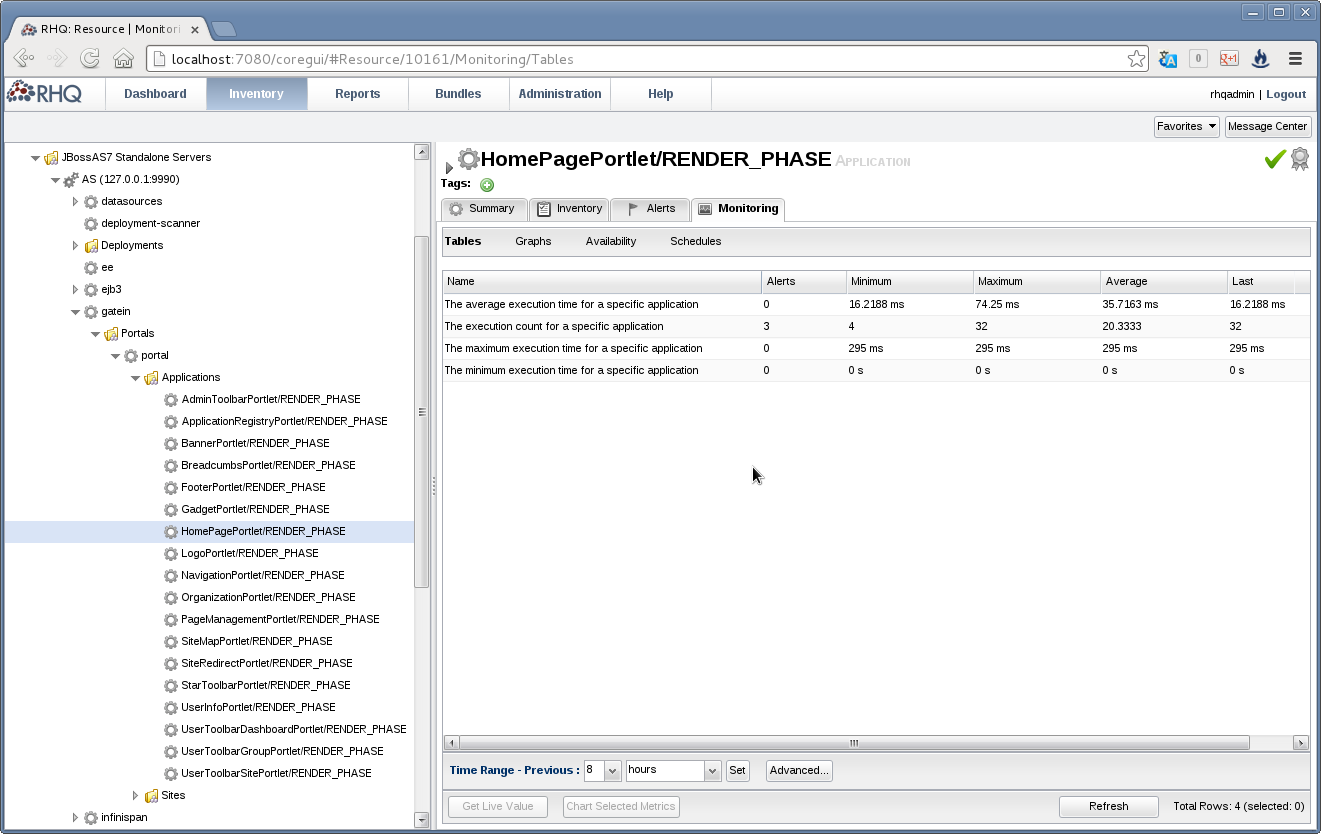Summary
The GateIn project provides an RHQ plugin to assist with the administrating and monitoring of GateIn in RHQ.
This plugin should work with community RHQ and GateIn 3.5 on as7, however it's been tested and is supported with JON 3.x and JPP 6.x
The GateIn RHQ plugin is based off the AS7 plugin, which allows the plugin to communicate to the GateIn AS7 subsystem to gather information. Currently the plugin supports the gathering of metrics which are obtained from the portal instance.
Plugin Installation
To install the GateIn RHQ plugin you need to build the gatein-rhq project and copy the artifact, i.e. target/gatein-as7-rhq-plugin.jar to the $RHQ_SERVER/plugins directory. Once copied (assuming RHQ server has been installed and is started) you can navigate to the Administration tab at the top of RHQ Web Console and choose Agent Plugins in the Configuration pane towards the bottom left. Once selected, you can 'Scan for udpates' in order for RHQ to install the GateIn plugin. After it's complete you should now see now 'GateIn AS7 Plugin' in the list of available plugins.

For more information on how to install/configure RHQ, consult the RHQ Installation Documentation
The agent may also need to be updated to pick up the GateIn plugin. This can be accomplished by typing plugins update in the agent console.
Metrics
The metrics collected by the plug-in include Site and Application statistics. Each application contains statistics relevant to the individual application while site statistics are gathered for the entire site.
These metrics/statistics are runtime only values. In other words, the values are not persisted anywhere on the server. Each start of the portal will bring a new set of data (max time, min time, etc); however, RHQ will keep a history of these measurements to give an accurate view of the data over time.
Note that discovery of sub-resources (such as Sites and Portlet Applications) is performed only once a day by JON. Hence, it is normal that new Sites and Applications do not appear immediately in JON, unless one triggers a manual discovery.
The manual discovery can be triggered in the JON UI, under the top level server node (e.g. "localhost.localdomain") > Operations > Schedules > New > Operation: "Run Autodiscovery", Detailed Discovery: yes.
Site Statistics
|
Metric |
Description |
|
Maximum Execution Time |
The maximum execution time that a page took to process for a particular site. |
|
Minimum Execution Time |
The minimum execution time that a page took to process for a particular site. |
|
Average Execution Time |
The average execution time that a page took to process for a particular site. |
|
Execution Count |
The amount of times a site has been accessed. |
|
Throughput |
The number of requests per second for a site. |

Application Statistics
|
Metric |
Description |
|
Maximum Execution Time |
The maximum execution time for an application/portlet to process. |
|
Minimum Execution Time |
The minimum execution time for an application/portlet to process. |
|
Average Execution Time |
The average execution time for an application/portlet to process. |
|
Execution Count |
The amount of times an application has been accessed. |

For clustered environments, RHQ records data for each resource/server individually, however using RHQ Groups(Compatible, Mixed and DynaGroups) you can manually or automatically create groups to aggregate this data. For more information on this you can view documentation for RHQ Groups
Operations
The RHQ GateIn Plug-in itself does not provide any operations; it's sole purpose is reporting and statistics relating to applications and sites.
The RHQ AS plug-in, included in a standard RHQ install, does support many management operations. With the AS plug-in, the following non-exhaustive list of actions are possible:
-
Server control: start, stop, restart.
-
Application control: deploy, and remove EAR and WAR applications.
-
Resource control: manage other components of the platform, such as datasources.
For detailed information about RHQ, and how it can be used to manage platforms, refer to the project's documentation